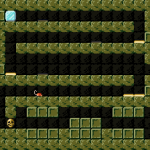
One of the great things about living and working in the Emeryville area is the local game development scene. Case in point: this afternoon, at the local coffee shop I ran into none other than the Chris Hecker, developer of Spy Party. We had spoken before briefly after a talk he gave at UC Berkeley, but this was the first chance I got to really chat with him.
Chris is the nicest guy ever, and was gracious enough to give me an hour out of his work day to check out Escape Goat and give me some feedback on it. Laptop only, and I had left my 360 controller at home. Chris happened to have one on him. Preparedness.
I got some great feedback on “initial impression” details such as the tutorial and mouse summon controls. The real value was in Chris’s perspective as an uber indie artist (he might even say perfectionist?) which is a new role among my playtesting group. (To contrast, an actual quote from my friend Ryan: “You’re giving them too much for $3. Get this thing out the door.”)
Given about 10 minutes of gameplay, Chris pointed out what the best parts were and what to focus on in building the rest of the game. Specifically, he said that while the platforming was cool, it wasn’t anything new, and I needed to find some new territory to conquer. He found two aspects interesting enough to be focused on and developed as far as possible:
- The interplay between the goat and mouse, and puzzles that involve using both at the same time to manipulate the world from two angles
- Rooms that transform and take more than one shape.
These are the “threads” that need to be tugged on to see where they lead. If the game has a hook, it has to do with one or both of these things.
 To focus on character switching and morphing levels doesn’t require any additional features: while rebuilding the game levels, I can just keep this in mind and use it as a guiding principle. He had some other, more risky ideas such as changing the visual perspective when changing control from the goat to the mouse–while totally awesome-sounding, I gotta put that off until the sequel.
To focus on character switching and morphing levels doesn’t require any additional features: while rebuilding the game levels, I can just keep this in mind and use it as a guiding principle. He had some other, more risky ideas such as changing the visual perspective when changing control from the goat to the mouse–while totally awesome-sounding, I gotta put that off until the sequel.
A dilemma that has plagued me since the beginning of this project is the sheer number of options I opened up in building the engine. It could be used to make an adventure game, a screen-by-screen puzzler, or an action platformer… or any combination of these things. Finding the right focus has been the real challenge. It’s been paralyzing to have so many options.
About a month ago I decided to limit the exploration and platforming aspects in level design, and focus more on the puzzles. Now I can go a step further and say that I have a clearer idea of the type of puzzles that will make my game unique. It’s close to beta! Coming soon…

